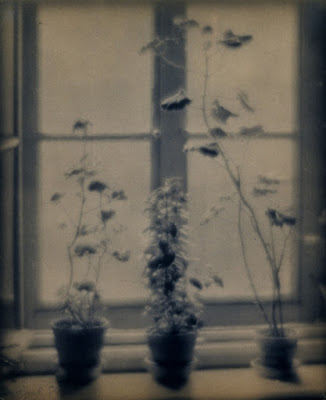 |
| Morton Schamberg Self Portrait 1912 platinum print Whitney Museum of American Art, New York |
The avant-garde artist Morton Schamberg died at age 37 in the influenza epidemic of 1918. His Cubist and Machine-Age aesthetic had collapsed during World War I as his pacifist ideals reacted against the violent horrors that proliferated.
 |
| Karl Struss Arverne, Low Tide 1912 platinum print Amon Carter Museum of American Art, Fort Worth, Texas |
 |
| Robert Mapplethorpe Andre 1984 platinum print Smithsonian American Art Museum, Washington DC |
 |
| William Clift Church, Cape Cod, Massachusetts 1981 platinum print Chrysler Museum of Art, Norfolk, Virginia |
 |
| David Davidson A Tribute to Raphael ca. 1900 hand-colored platinum print National Gallery of Canada, Ottawa |
 |
| Imogen Cunningham Marcia Tracy Marple, William Warren Marple ca. 1914 platinum print Smithsonian American Art Museum, Washington DC |
 |
| Peter Henry Emerson Water Lilies 1886 platinum print Metropolitan Museum of Art, New York |
 |
| Karl Struss The Attic Window, Desden 1909 platinum print Smithsonian American Art Museum, Washington DC |
 |
| Andrea Modica Oneonta, New York 1988 platinum-palladium print Smithsonian American Art Museum, Washington DC |
 |
| Andrea Modica Treadwell, NY 1986 platinum-palladium print Whitney Museum of American Art, New York |
 |
| Walter Barnett Lady Charlotte Russell (dressed for Edwardian Court Presentation) ca. 1905 platinum print Art Gallery of New South Wales, Sydney |
-Study-of-Woman-1908-platinum-print-Kunstbibliothek-Staatliche-Museen-zu-Berlin.jpg) |
| Minya Dièz-Dürhkoop Study of a Woman 1908 platinum print Kunstbibliothek, Staatliche Museen zu Berlin |
 |
| Gertrude Käsebier Portrait of artist Robert Henri 1907 platinum print Delaware Art Museum, Wilmington |
-2002-A-platinum-print-Portland-Museum-of-Art-Maine.jpg) |
| Tillman Crane McClellan House, Interior 2002 platinum print Portland Museum of Art, Maine |
-2002-B-platinum-print-Portland-Museum-of-Art-Maine.jpg) |
| Tillman Crane McClellan House, Exterior 2002 platinum print Portland Museum of Art, Maine |
 |
| Karl Struss Storm Clouds, La Mesa, California 1921 platinum print Amon Carter Museum of American Art, Fort Worth, Texas |
Ancient Text
How deeply fortunate my life, my every prayer
heard by the angels.
I asked for the earth; I received earth, like so much
mud in the face.
I prayed for relief from suffering; I received suffering.
Who can say my prayers were not heard? They were
translated, edited – and if certain
of the important words were left out or misunderstood, a critical
article deleted, still they were taken in, studied like ancient texts.
Perhaps they were ancient texts, re-created
in the vernacular of a particular period.
And as my life was, in a sense, increasingly given over to prayer,
so the task of the angels was, I believe, to master this language
in which they were not as yet entirely fluent or confident.
And if I felt, in my youth, rejected, abandoned,
I came to feel, in the end, that we were, all of us,
intended as teachers, possibly
teachers of the deaf, kind helpers whose virtuous patience
is sustained by an abiding passion.
I understood at last! We were the aides and helpers,
our masterpieces strangely useful, like primers.
How simple life became then; how clear, in the childish errors
the perpetual labor: night and day, angels were
discussing my meanings. Night and day I revised my appeals,
making each sentence better and clearer, as though one might
elude forever all misconstruction. How flawless they became –
impeccable, beautiful, continuously misread. If I was, in a sense,
an obsessive staggering through time, in another sense
I was a winged obsessive, my moonlit
feathers were paper. I lived hardly at all among men and women;
I spoke only to angels. How fortunate my days,
how charged and meaningful the nights' continuous silence and opacity.
– Louise Glück (2001)